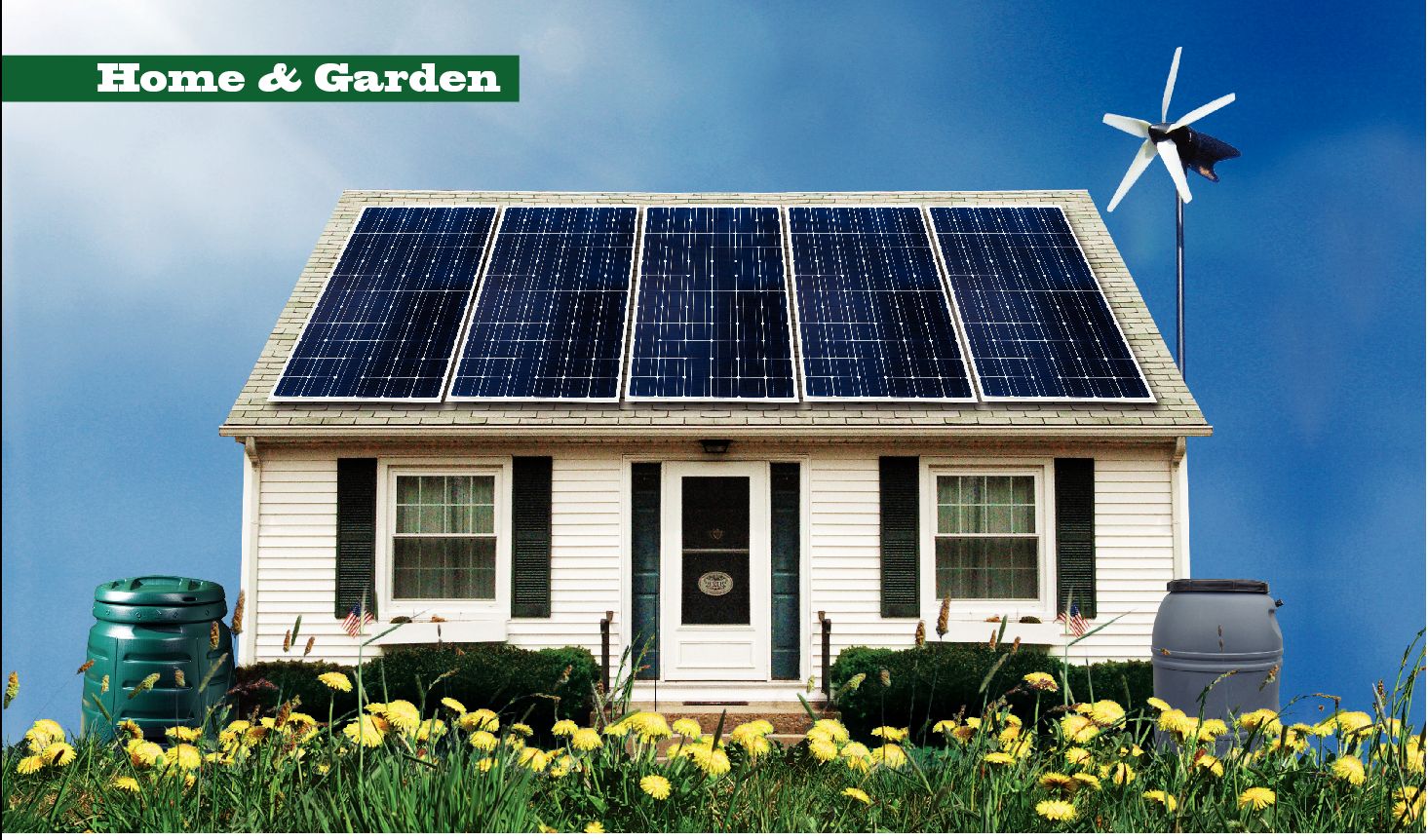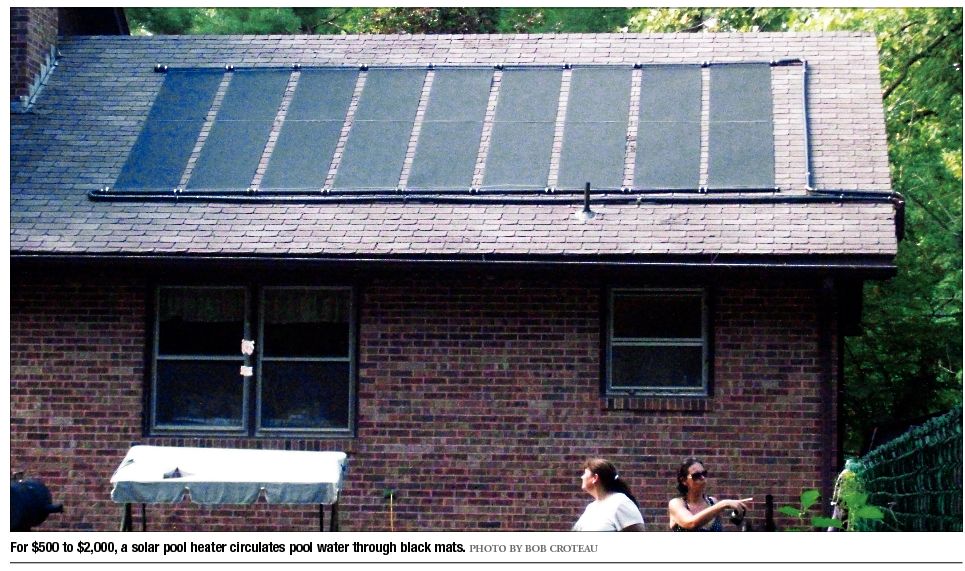
Renew your home with solar and wind
Now is the time to invest in renewables
ENERGY | Karen Fitzgerald
If you’re considering adding solar energy to your home, now may be a good time to do it. Solar panel prices are low because demand slumped after the financial crisis of 2008, when the renewables industry was booming in Japan, Germany, Spain and California. Surplus panels piled up in warehouses and prices dropped as a result.
What’s more, solar insiders predict prices will soon be rising because Illinois law requires utilities to include solar in their power mix starting in 2012. Most utilities have been fulfilling the law’s renewable energy quota with wind farm energy, but they must begin ramping up solar sources until they reach six percent of power from solar by the year 2015. “If people get in now, they can do it before prices go up,” says Bob Croteau, who leads workshops on renewable energy at Lincoln Land Community College.
Homeowners usually choose renewable technology for the environmental benefits, but Michelle Marley, owner of WindSolarUSA in Owaneco, Ill., says it also makes sense on a purely economic basis. In a time of escalating utility prices, she says, “what you’re really doing with a renewable system is fixing your energy costs” for 20 to 25 years – the life of the system. “You know what you’re paying, you know what it’s going to give you.”
Croteau sees it as an investment that will pay for itself over time, as long as homeowners avoid scammers selling useless products. “We suffered through scams in the early 80s when renewable energy was hot,” he recalls. “Companies were quickly formed to sell stuff that wasn’t well researched or designed for this climate, and they overpriced it to take advantage of the tax credit.”
Croteau and Marley spoke with Illinois Times about some of the best green technologies for Illinois homeowners and what to watch out for.
Solar swimming pool heating. This is a good option for homeowners who want to dip their toe into renewables before jumping in. Your pool’s filter pump can be hooked up to circulate water through a black solar mat. Just roll it out flat and attach it to the roof, house deck, or side of the pool. If you heat your pool, you can save all your heating costs for an investment of $500 to $2,000. Croteau, an energy planner with City Water Light & Power, says it’s “the most cost efficient thing you can do.” If you don’t heat your pool, the solar mat will extend pool use by a month in spring and another month in fall.
Solar hot water heating. Croteau calls this “a really tried and true” technology that can supply about half your water heating year-round.
You don’t need to replace your current water heater. Just add another 80- to 100-gallon electric water tank to store the solar-heated water and connect it to your current heater where cold city water normally goes in. Less power will be required to keep your water hot as a result. Antifreeze flows through the solar collector and transfers its heat to the water in the storage tank via a heat exchanger. For easier maintenance, the heat exchanger can be mounted on the wall above the tanks with two small pumps. One pump circulates cold city water to the heat exchanger for warming and then into the storage tank, and in a separate loop, the other pumps antifreeze through the solar collector and down to the heat exchanger. If you don’t get enough sun on your roof, you can put collectors on the ground or on an awning with this system.
If you can put a collector on your roof, a more efficient option is to let the fluid fall back down into the storage tank at night or whenever the pump shuts off. This so-called drainback system requires the least maintenance of any solar hot water design, typically running 20 years with no service.
With two flat plate solar collectors (enough for a family of four), a solar hot water system would cost anywhere from $2,500 to $4,000, including installation. Croteau estimates the system will pay for itself in 5 to 10 years.
A recent addition to the market is evacuated tube collectors, which are more efficient than flat plate collectors. Instead of copper tubes running across a flat plate that absorbs the sun’s heat, the fluid lines are surrounded by a vacuum, resulting in virtually no heat loss. They can heat fluids to higher temperatures than flat plate collectors, and any excess energy can be easily applied to heating bathroom and kitchen floors in winter. Evacuated tube technology performs better in cold weather than flat plate, so would be an advantage in Illinois winters. A two-panel system using evacuated tube technology costs $5,000 to $6,000.
Of course, costs would
be lower if you can get by with one panel rather than two. Lowflow
showerheads and lather valves that pause the water while soaping and
shampooing can cut water usage in half, Croteau notes.
Solar
hot air collectors. Jan Kessinger has had one of these on his house
near Lake Springfield since the early 1980s. Three 4- by-6-foot panels
hanging on the south wall of his house include a black absorber plate
that warms air piped in from a bedroom. A small fan drives the
solar-heated air into his basement, where it rises to heat the entire
house. When he and his wife migrate to warmer climes for three months in
winter, it provides all the heating needed to prevent the house from
freezing. “I should have put one in 20 years earlier,” Kessinger says.
“They pay for themselves.”
Their
vertical orientation on the outside wall of a house puts the collectors
at a good angle for the low Illinois sun in winter, Croteau notes.
Furthermore, reflection off snow will increase the sunlight reaching
them. You can put up one collector or more depending on your needs. One
collector will heat 500 square feet during daytime and generate 5
million BTUs over the winter season.
You can buy a solar hot air collector for $1,000 to $2,000, or make one yourself for $400 using Croteau’s booklet, Do-It-Yourself Solar Hot Air Collectors, available
from CWLP. They don’t qualify for the federal tax credit, but they pay
back their cost in two to five years. Marley recommends them for
warehouses or barns rather than homes because of fan noise. Croteau says
a good fan makes no more noise than a furnace or refrigerator.
Solar
electricity. Photovoltaics are the premier solar technology because
they generate electricity, which means they can power your kitchen
appliances, computers and air conditioning. They also have the advantage
of performing best during Illinois summers when electrical usage is at
its peak due to air conditioning. The sun shines 70 percent of the time
during our summers, as compared to 30 percent during winter. And
photovoltaic panels are practically maintenance-free. “The worst you’re
going to have to do is brush snow off it in the winter, or hose it off
if it gets dust on it in the summer,” says Marley.
There
are two main kinds of photovoltaic cells – crystalline and amorphous,
or thin film. Crystalline cells are the “workhorse of the industry,”
Croteau says. “The ones that were installed 25 years ago are still
working.” Most panels are guaranteed for 25 years, but they can operate
much longer at slightly reduced output. Amorphous cells are cheaper, but
more are required to produce the same amount of electricity, so the
mounting costs are higher. As a result, no matter what technology is
chosen, “solar ends up being the same cost per watt,” Croteau says. Most
residential systems cost between $8,000 and $24,000, but will pay for
themselves in 10 to 15 years.
To
ensure good results, it’s important to get a professional assessment of
your site for solar access. Unlike other solar technologies,
photovoltaic panels don’t generate electricity unless the sun is shining
on the entire panel. So your site’s solar access from 9 a.m. to 3 p.m.
is critical in determining whether photovoltaics will benefit you. If your roof has too much shading or doesn’t have a
south-facing slope, Marley says you can put solar panels on a garage
roof, the ground or even a solar shed placed on an unshaded portion of
property, with all controls concealed inside the shed.
continued on page 16
Legislature depletes green incentive
Illinois is one of only
22 states that offer a rebate on renewable technology for homeowners. It
has one of the better programs, returning 30 percent of product and
installation costs for both wind and solar, including pool heating. But
the rebate was available for only five weeks last fall before funding
ran out for the current (2011) fiscal year. Out of 300 applications, the
Department of Commerce and Economic Opportunity paid rebates amounting
to $1.5 million to less than 130 applicants, according to Marcelyn Love,
DCEO spokesperson.
The
rebate fund, which comes from an assessment customers pay on their
utility bills, has been raided every year since 2008 by the Illinois
General Assembly to pay the state’s debts. The legislature took $5
million from the fund in 2008 and more than $13 million in 2009.
“When the state quit
giving incentives, it kind of shut the whole industry down around here,”
says Rich Marsaglia of Haenig Electric Company. Based in Springfield
since 1904, the company just began handling commercial solar projects a
year ago, installing solar panels on FitClub South and Southwind Park’s
visitor center.
The
rebate should be available again at some point in the next fiscal year
on a first-come, first-served basis. But CWLP customers don’t qualify
for it because cityowned CWLP isn’t required to charge the assessment.
Still,
there are other incentives available, beginning with the 30 percent
federal tax credit. See a full listing on the Database of State
Incentives for Renewables and Efficiency website www.dsireusa.org.

